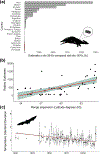Climate change linked to vampire bat expansion and rabies virus spillover
- PMID: 39712434
- PMCID: PMC11661686
- DOI: 10.1111/ecog.06714
Climate change linked to vampire bat expansion and rabies virus spillover
Abstract
Bat-borne pathogens are a threat to global health and in recent history have had major impacts on human morbidity and mortality. Examples include diseases such as rabies, Nipah virus encephalitis, and severe acute respiratory syndrome (SARS). Climate change may exacerbate the emergence of bat-borne pathogens by affecting the ecology of bats in tropical ecosystems. Here, we report the impacts of climate change on the distributional ecology of the common vampire bat Desmodus rotundus across the last century. Our retrospective analysis revealed a positive relationship between changes in climate and the northern expansion of the distribution of D. rotundus in North America. Furthermore, we also found a reduction in the standard deviation of temperatures at D. rotundus capture locations during the last century, expressed as more consistent, less-seasonal climate in recent years. These results elucidate an association between D. rotundus range expansion and a continental-level rise in rabies virus spill-over transmission from D. rotundus to cattle in the last 50 years of the 120-year study period. This correlative study, based on field observations, offers empirical evidence supporting previous statistical and mathematical simulation-based studies reporting a likely increase of bat-borne diseases in response to climate change. We conclude that the D. rotundus rabies system exemplifies the consequences of climate change augmentation at the wildlife-livestock-human interface, demonstrating how global change acts upon these complex and interconnected systems to drive increased disease emergence.
Keywords: bats; climate change; emerging infectious disease; rabies; spillover.
Figures


Similar articles
-
Future climate change and the distributional shift of the common vampire bat, Desmodus rotundus.Sci Rep. 2025 Feb 18;15(1):5989. doi: 10.1038/s41598-025-87977-7. Sci Rep. 2025. PMID: 39966449 Free PMC article.
-
Rabies transmitted from vampires to cattle: An overview.PLoS One. 2025 Jan 13;20(1):e0317214. doi: 10.1371/journal.pone.0317214. eCollection 2025. PLoS One. 2025. PMID: 39804921 Free PMC article.
-
Assessing the potential impacts of a changing climate on the distribution of a rabies virus vector.PLoS One. 2018 Feb 21;13(2):e0192887. doi: 10.1371/journal.pone.0192887. eCollection 2018. PLoS One. 2018. PMID: 29466401 Free PMC article.
-
Anticoagulants for the Control of the Common Vampire Bat (Desmodus rotundus).Zoonoses Public Health. 2025 Mar;72(2):101-116. doi: 10.1111/zph.13196. Epub 2024 Dec 22. Zoonoses Public Health. 2025. PMID: 39710827 Free PMC article. Review.
-
A review of the diet of the common vampire bat (Desmodus rotundus) in the context of anthropogenic change.Mamm Biol. 2023 Jun 12:1-21. doi: 10.1007/s42991-023-00358-3. Online ahead of print. Mamm Biol. 2023. PMID: 37363038 Free PMC article. Review.
Cited by
-
The reemergence of the New World screwworm and its potential distribution in North America.Sci Rep. 2025 Jul 3;15(1):23819. doi: 10.1038/s41598-025-04804-9. Sci Rep. 2025. PMID: 40610581 Free PMC article.
-
Future climate change and the distributional shift of the common vampire bat, Desmodus rotundus.Sci Rep. 2025 Feb 18;15(1):5989. doi: 10.1038/s41598-025-87977-7. Sci Rep. 2025. PMID: 39966449 Free PMC article.
-
Risk of Nipah Virus Seroprevalence in Healthcare Workers: A Systematic Review with Meta-Analysis.Viruses. 2025 Jan 9;17(1):81. doi: 10.3390/v17010081. Viruses. 2025. PMID: 39861870 Free PMC article.
-
Rabies transmitted from vampires to cattle: An overview.PLoS One. 2025 Jan 13;20(1):e0317214. doi: 10.1371/journal.pone.0317214. eCollection 2025. PLoS One. 2025. PMID: 39804921 Free PMC article.
References
-
- Anderson A, Shwiff SS and Shwiff SA 2014. Economic impact of the potential spread of vampire bats into south Texas. – Proceedings of the 26th Vertebrate Pest Conference, pp. 305–309.
-
- Arellano-Sota C. 1988a. Biology, ecology, and control of the vampire bat. – Rev. Infect. Dis. 10: 461–476. - PubMed
-
- Arellano-Sota C. 1988b. Vampire bat-transmitted rabies in cattle. – Rev. Infect. Dis. 10: S707–S709. - PubMed
-
- Barlow J, França F, Gardner TA, Hicks CC, Lennox GD, Berenguer E, Castello L, Economo EP, Ferreira J, Guénard B, Gontijo Leal C, Isaac V, Lees AC, Parr CL, Wilson SK, Young PJ and Graham NAJ 2018. The future of hyperdiverse tropical ecosystems. – Nature 559: 517–526. - PubMed
Grants and funding
LinkOut - more resources
Full Text Sources
Miscellaneous
